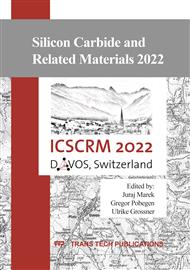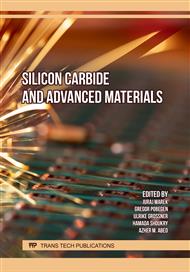p.23
p.31
p.37
p.45
p.51
p.57
p.63
p.71
p.81
Recent Progress in Non-Contact Electrical Characterization for SiC and Related Compounds
Abstract:
An increasing interest in the non-contact corona charge-based electrical characterization technique, CnCV, for wide bandgap semiconductors, is justified by the reduction of cost and the reduction of testing feedback time [1]. In addition, the technique expands measurement capabilities. Regarding SiC, recent progress includes expanded dopant concentration range and dopant measurement on fresh epitaxial wafers. The latter is made possible with an ultraviolet wafer pretreatment technique [2]. The novel applications to AlGaN/GaN HEMT on insulating substrates demonstrate the benefits of a noninvasive top side edge contact, TSEC [3], that eliminates the problem of the floating surface potential. This development enables a unique three variable, charge-voltage-capacitance (Q-V-C), characterization of AlGaN/GaN on sapphire and SI-SiC. The quasistatic CnCV measurement, not affected by series resistance, is shown to be suitable for wafer mapping of HEMT parameters. The CnCV version with TSEC can be combined with an eddy current technique enabling non-contact 2DEG mobility measurements vs. electron sheet density.
Info:
Periodical:
Pages:
51-56
Citation:
Online since:
May 2023
Permissions:
Share:
Citation:



